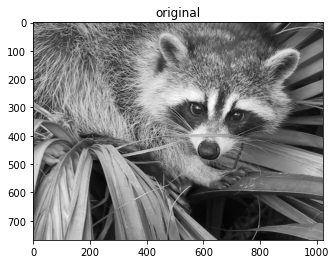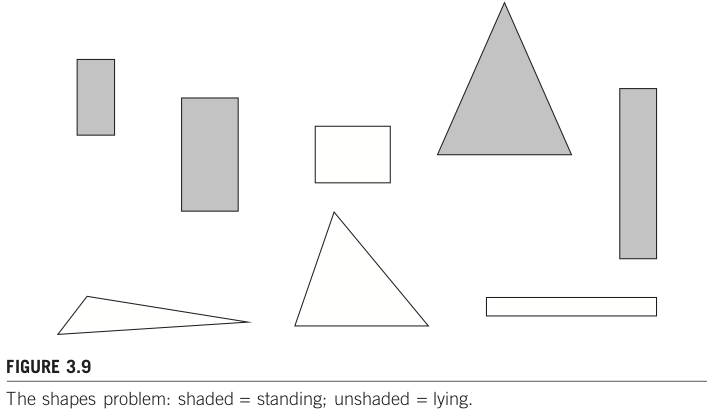SVDによる圧縮の例(not 次元削減)
目次
SVDによる圧縮の例(not 次元削減)¶
全体の流れ
画像ファイルをグレイスケールに変換する。(そのままだとR, G, Bの3レイヤー分の行列があるので、今回はグレイスケールに変換して1つの行列として扱う)
グレイスケールが保存されている行列を特異値分解する。
分解によりどのぐらい近似できているのかを確認する。
近似度合いがどのぐらいあるのかを可視化して確認する。
from scipy import misc
import matplotlib.pyplot as plt
import numpy as np
画像データの準備¶
img = misc.face()
print(type(img))
plt.imshow(img)
<class 'numpy.ndarray'>
<matplotlib.image.AxesImage at 0x118293ac0>
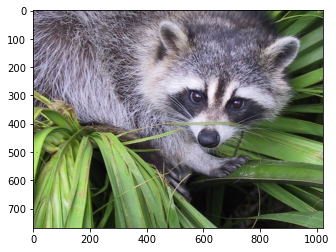
画像データのshape確認¶
print(img.shape)
print(img[:, :, 0])
plt.imshow(img[:, :, 0])
(768, 1024, 3)
[[121 138 153 ... 119 131 139]
[ 89 110 130 ... 118 134 146]
[ 73 94 115 ... 117 133 144]
...
[ 87 94 107 ... 120 119 119]
[ 85 95 112 ... 121 120 120]
[ 85 97 111 ... 120 119 118]]
<matplotlib.image.AxesImage at 0x1183a2fd0>
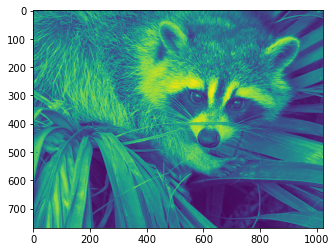
グレイスケール変換¶
\(grayscale = 0.2126R + 0.7152G + 0.0722B\)
img_array = img / 255
grayscale = img_array @ [0.2126, 0.7152, 0.0722]
plt.imshow(grayscale, cmap="gray")
<matplotlib.image.AxesImage at 0x1184231f0>
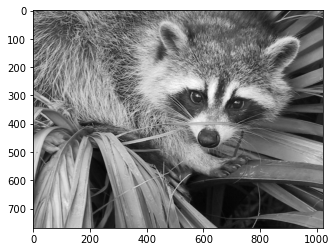
特異値分解¶
U, s, Vt = np.linalg.svd(grayscale)
print(U.shape, s.shape, Vt.shape)
(768, 768) (768,) (1024, 1024)
sを対角行列に変換¶
sは対角行列。正方行列ならnp.diag()で変換できるが、特異値分解で出てくる特異値は行列サイズが異る(U, Vtに合わせる必要がある)。そこで、サイズを指定したゼロ行列を作成して対角成分のみコピーすることで作成している。
# 対角行列に変換
sigma = np.zeros((U.shape[1], Vt.shape[0]))
for i in range(U.shape[1]):
sigma[i, i] = s[i]
# 特異値分解によりどのぐらい近似できているかを確認
approximation = np.dot(np.dot(U, sigma), Vt)
diff = grayscale - approximation
print(np.linalg.norm(diff))
1.5653515009052408e-12
# 特異値分解によりどのぐらい近似できているかを確認
np.allclose(grayscale, approximation)
True
# 特異値の大きさを確認
plt.plot(s)
[<matplotlib.lines.Line2D at 0x118488a30>]
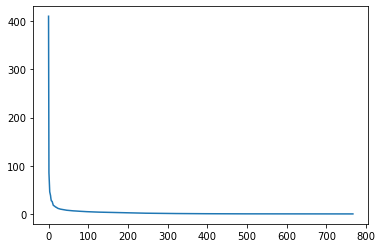
圧縮してみる¶
特異値の大きい順に「特異値1〜100位までで近似した場合」を確認。
k = 100
approximation = np.dot(np.dot(U, sigma[:, :k]), Vt[:k, :])
plt.imshow(approximation, cmap="gray")
<matplotlib.image.AxesImage at 0x1184f3a00>

# 特異値1位〜20位までの間で確認してみる
approximation = []
ks = [1, 5, 10, 20]
for k in ks:
approximation.append(np.dot(np.dot(U, sigma[:, :k]), Vt[:k, :]))
# オリジナル
plt.imshow(grayscale, cmap="gray")
plt.title("original")
# 近似
fig, axes = plt.subplots(nrows=1, ncols=4, figsize=(15,5))
for ax, app, k in zip(axes, approximation, ks):
ax.imshow(app, cmap="gray")
ax.set_title("k = {}".format(k))
